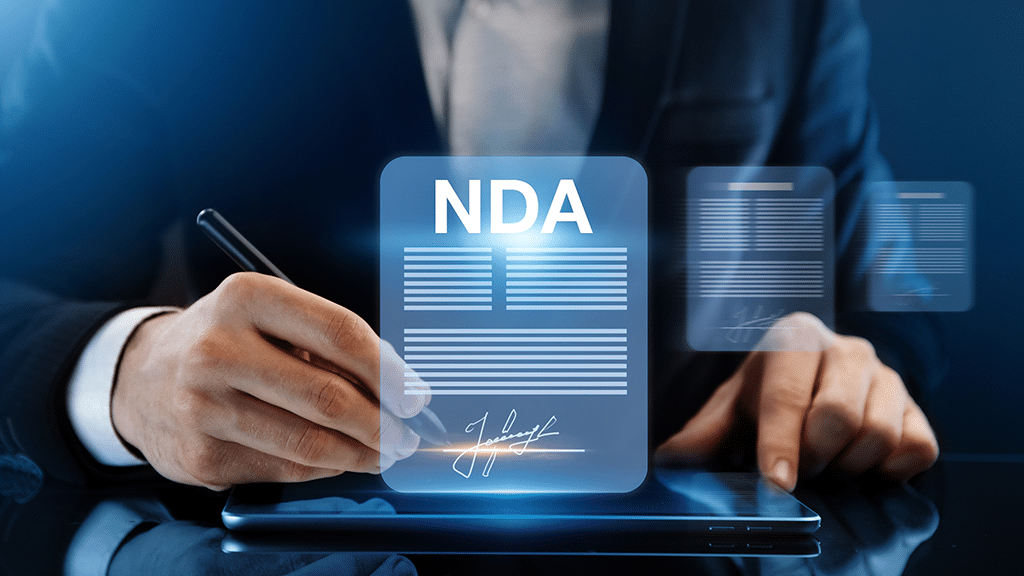NDA Template Essentials & Key Insights
“Create Strong Partnerships and Protect your Confidential Business Data with NDA templates“
Imagine your company taking the lead in a specific industry with advanced solutions! It’s not a far stretch if you keep your trade secrets and recently developed products confidential. To keep your market position or gain a competitive advantage, make sure your intellectual property and sensitive information are kept safe with a simple Non-Disclosure Agreement (NDA).
These NDA templates and documents are designed to protect your latest innovations from competitors and public knowledge. For more information on what NDAs are, what they are made of, and the different types you can have in real life, join us in the article below. We also fill you in on Titan CLM and how you can use this zero-code application to create NDAs in minutes so you can get on with creating those classified projects with no stress.

What Is a Non-Disclosure Agreement?
It is a legal contract, also known as a confidentiality agreement. People use Non-Disclosure Agreements (NDAs) when they need to specify how information is kept private between two or more parties. For example, a Non-Disclosure Agreement for employees blocks them from revealing the information in it to unauthorized members.
Essential Parts of Non-Disclosure Agreement Template
A Non-Disclosure Agreement definition is not complete without explaining some of its components, so here are a few to consider.
Identifying Parties
A basic Non-Disclosure agreement will include the identities of the parties who are involved in the agreement.
Outline of Confidential Material
The document will state what can be considered private information. This could take the form of documents or data.
Exceptions to Confidentiality
This part of the NDA will inform parties about which information is not confidential. Examples could include:
- Information already known by the public
- Information that can become public by no fault of the party in the agreement
Permitted Information Use
This section covers what parties can do with the confidential data shared in the NDA.
Duration of Agreement
An NDA should indicate the times when the agreement will start and finish between parties. It should also provide the dates and times that the confidentiality obligation is valid for parties.
Consequences of Agreement Violations
This section is needed in the NDA in case of a contract breach by any party. It will explain the repercussions, legal actions, and damages if this event has to occur.
Special Provisions and Restrictions
Adding a Special Provisions and Restrictions section to an NDA is important. This section will explore clauses specific to the NDA’s needs and requirements. The provisions section will give parties more protection and explain when confidential information can be used or revealed to the public.

Types of Non-Disclosure Agreements
Non-disclosure agreements come in a variety of forms. Here are three examples of NDAs you can find in the real world.
1. Standard Non-Disclosure Agreement
These are common templates that can be used in any industry. They are designed to keep information confidential between members in an agreement. Standard NDA templates are used to collaborate better in business partnerships.
For example, a standard NDA template can be used when two businesses want to start a partnership or a project. The standard NDA will give businesses in the agreement a way to securely and confidently share the following:
- Business Plans
- Financial Details
- Technology
Tech startups partnering with other organizations to share skills, tech, and software are good candidates for using a standard NDA.
2. Mutual Non-Disclosure Agreement
Also known as MNDA, this type of contract template is legally binding and ensures that information remains private between two or more parties in an agreement. It differs from NDA as they include a bilateral exchange of sensitive information. This means that all parties are sharing confidential data.
MNDAs are useful when businesses want to start a joint project. With an MNDA in place, businesses can securely and freely share the following information with each other:
- Technology
- Financial Details
- Market Research
As an example, an MNDA would be extremely useful for a tech and car company that wants to start a project. After signing this agreement, both companies can create advanced vehicle technology.
3. Employee Non-Disclosure Agreement
This contract is a legally binding document between an employer and employee. It serves as proof that the employee will keep sensitive data private. Businesses use Employee NDAs to protect their proprietary data while ensuring colleagues do not leak sensitive information while working on projects.

A common place for Employee NDAs is in the tech space. A tech business can use them when hiring developers to create software. The Employee NDA will allow the company to protect the following types of information:
- Source Code
- Algorithms
- Technical Specs
With an Employee NDA in place, a business can gain an edge over competitors as its employees work on confidential software.
Titan CLM for Efficient NDA Workflows
From the information above, we can agree that NDAs are essential for legal and business operations. They protect sensitive information, such as trade secrets and intellectual property. However, creating an NDA from scratch each time you need one can be super time-consuming.
There are many components to an NDA, and they need to be legally correct, too. So, if you need to optimize your NDA creation and other contract management processes, we recommend Titan CLM (Contract Lifecycle Management). Our contract management software integrates directly into Salesforce to simplify working with your data and documents.
With Titan CLM, you can redline, edit, and comment on any NDA while tracking every action in Salesforce. But that is just the start of what you can do with Titan CLM. Look at our other no-code features that can accelerate how you work in the office.

Titan CLM on Salesforce AppExchange
This is just the beginning of what you can do with our sweet collection of contract lifecycle management features. For a full feature breakdown or advice on optimizing your NDA-related tasks and processes, contact us through one of our social media links below or find us on the AppExchange marketplace.
We hope to see you soon!

Disclaimer: The comparisons listed in this article are based on information provided by the companies online and online reviews from users. If you found a mistake, please contact us.
Frequently Asked Questions
How do you format a Non-Disclosure Agreement?
You should give it a clear structure and include the following sections:
- The Parties Involved in the NDA
- Explanation of What is Confidential Information
- The Obligations of Parties
- The Exclusions of Confidential Information
- The Permitted Use of NDA Information
- The Duration of the NDA
- Consequences of a Breach
- The Governing Laws of the NDA
Remember that an NDA is a legally binding document. For this reason, a lawyer should be consulted to read through the NDA and ensure it adheres to legal requirements.
What are the consequences of breaking an NDA?
There are serious results for breaking an NDA, which could include:
- Legal Cases
- Fines
- Reputational Losses
The exact consequence for breaking an NDA will be found in the contract and will depend on the location and laws in which it operates.
Why are Non-Disclosure Agreements essential to business?
Besides protecting confidential information, NDAs are important to businesses because they outline contractual obligations. These clauses protect a business by making parties’ legal obligations very clear so that if a contract is breached, there will be consequences and justice served.
